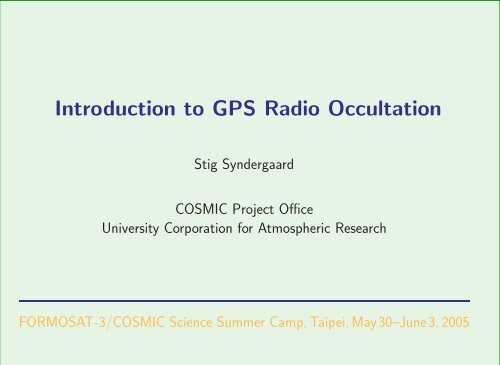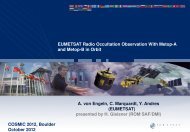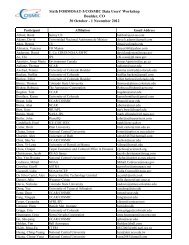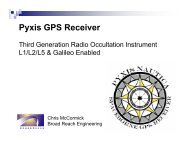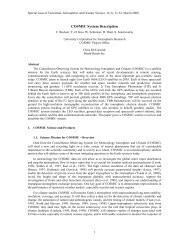nr - COSMIC - University Corporation for Atmospheric Research
nr - COSMIC - University Corporation for Atmospheric Research
nr - COSMIC - University Corporation for Atmospheric Research
You also want an ePaper? Increase the reach of your titles
YUMPU automatically turns print PDFs into web optimized ePapers that Google loves.
Introduction to GPS Radio Occultation<br />
Stig Syndergaard<br />
<strong>COSMIC</strong> Project Office<br />
<strong>University</strong> <strong>Corporation</strong> <strong>for</strong> <strong>Atmospheric</strong> <strong>Research</strong><br />
FORMOSAT-3/<strong>COSMIC</strong> Science Summer Camp, Taipei, May30–June3, 2005
The basics<br />
Topics of lecture<br />
• The GPS radio occultation principle<br />
• GPS observations (what is the signal?)<br />
• Derived products (what comes out of it?)<br />
Inversion of GPS radio occultation data<br />
• From signal to products (next slide)<br />
Advanced topics<br />
• <strong>Atmospheric</strong> multipath propagation<br />
• Super refraction
Topics of lecture (continued)<br />
Inversion of GPS radio occultation data<br />
• Excess phase → excess Doppler<br />
• Excess Doppler → bending angle<br />
– Correction <strong>for</strong> Earth’s oblateness<br />
– Ionospheric correction<br />
– Statistical optimization<br />
• Bending angle → refractivity<br />
– The Abel trans<strong>for</strong>m (the core of the data inversion)<br />
• Refractivity → pressure, temperature & humidity<br />
Ionospheric data<br />
• Phase differential → total electron content (TEC)<br />
• Total electron content → electron density
The GPS radio occultation principle<br />
GPS = Global Positioning System<br />
LEO = Low Earth Orbiter<br />
α = Bending angle (max ∼2 ◦ )<br />
Signal frequencies: f1 = 1.57542 GHz & f2 = 1.22760 GHz<br />
Refractive index of medium: n ≈ 1+77.6 p e<br />
+3.73×105<br />
T T 2+40.3Ne f 2
Basic GPS occultation observations<br />
Basic measurement is a phase path (meters): L =<br />
a) The Doppler depends on Φ and �v<br />
b) With bending, the Doppler is different<br />
than expected from velocities<br />
only<br />
� LEO<br />
n ds<br />
GPS<br />
Excess phase (path) is defined as: ∆L = L − |�r − �r |<br />
LEO GPS<br />
We are interested in the phase change: excess Doppler = d∆L/dt
The bending effect<br />
Curved signal path through the atmosphere<br />
• The signal path is curved according to Snell’s law because of<br />
changes in the index of refraction along the path<br />
• In a spherically symmetric medium, Snell’s law is replaced by<br />
Bouger’s law:<br />
<strong>nr</strong> sin ψ = a = constant<br />
ray path<br />
n ( r)−field<br />
r<br />
ψ
The bending effect<br />
Bouger’s law leads to (e.g., Fjeldbo et al. 1971):<br />
α(a) = −2a<br />
� ∞<br />
r0<br />
d ln n/dr<br />
√ n 2 r 2 − a 2 dr<br />
where bending toward the Earth is counted positive and r0 is the<br />
radius at the tangent point: n(r0)r0 = a
Derived data products<br />
Basic assumption: local spherical symmetry<br />
• Bending angle as a function of impact parameter, a (ray asymptote)<br />
– Numerical weather prediction & Climate research<br />
• Refractivity (defined as N = (n−1)×10 6 ) as a function of altitude<br />
– Numerical weather prediction & Climate research<br />
• Temperature, pressure (geopotential height), and humidity profiles<br />
– <strong>Atmospheric</strong> & Climate research<br />
Ionospheric data<br />
• Total electron content between GPS and LEO<br />
– Input to space weather models<br />
• Electron density as a function of altitude<br />
– Ionospheric research
Data product characteristics<br />
Accuracy of derived refractivity<br />
• Mean accuracy less than 0.5% between 2 and 25 km<br />
• Standard deviation less than 1% between 5 and 25 km<br />
• In the troposphere: Accuracy limited by horizontal gradients<br />
• Above ∼30 km: accuracy limited by thermal and ionospheric noise<br />
• Below ∼2 km: tracking errors may dominate<br />
Vertical resolution<br />
• ∼100 m in lower troposphere, increasing to ∼1.5 km in stratosphere<br />
Ionospheric data<br />
• Accuracy of electron density profiles limited by horizontal gradients<br />
• Vertical resolution determined by sampling rate (∼2 km <strong>for</strong> 1 Hz data)
L 1,L<br />
A ,A<br />
1<br />
2<br />
2<br />
Satellite orbits &<br />
Spherical symmetry<br />
L 1,L2<br />
Data processing chain<br />
L1 and L2 phase and amplitude<br />
Single path<br />
Radio holographic methods, multipath<br />
α ,α<br />
1 2<br />
Ionospheric correction<br />
L1 and L2 bending angle<br />
High altitude climatology & Abel inversion<br />
L1 and L2 phase<br />
α<br />
Iono−free bending angle<br />
N<br />
Auxiliary meteorological data<br />
Refractivity<br />
T,e,p
excess phase (m)<br />
Excess phase — what does it look like?<br />
3000<br />
2500<br />
2000<br />
1500<br />
1000<br />
500<br />
0<br />
GPS/MET, 1995, doy 174, 1:56 UTC, 16.7S, 171.1E<br />
L1<br />
L2<br />
LC<br />
-500<br />
0 10 20 30 40 50 60 70 80 90<br />
time since start of occultation (s)<br />
excess phase (m)<br />
9<br />
8<br />
7<br />
6<br />
5<br />
4<br />
3<br />
2<br />
1<br />
0<br />
GPS/MET, 1995, doy 174, 1:56 UTC, 16.7S, 171.1E<br />
L1<br />
L2<br />
LC<br />
-1<br />
0 5 10 15 20 25 30<br />
time since start of occultation (s)<br />
• An occultation typically lasts about 1 minute (sometimes more)<br />
• The excess phase can become as large as a few km near the surface<br />
∆LC(t) = f 2 1 ∆L1(t) − f 2 2 ∆L2(t)<br />
f 2 1 − f 2 2<br />
= LC(t) − |�r GPS − �r LEO|
excess phase (m)<br />
Excess phase — what does it look like?<br />
3000<br />
2500<br />
2000<br />
1500<br />
1000<br />
500<br />
0<br />
GPS/MET, 1995, doy 174, 1:56 UTC, 16.7S, 171.1E<br />
L1<br />
L2<br />
LC<br />
-500<br />
0 10 20 30 40 50 60 70 80 90<br />
time since start of occultation (s)<br />
excess phase (m)<br />
0.35<br />
0.3<br />
0.25<br />
0.2<br />
0.15<br />
0.1<br />
0.05<br />
0<br />
GPS/MET, 1995, doy 174, 1:56 UTC, 16.7S, 171.1E<br />
L1<br />
L2<br />
LC<br />
-0.05<br />
0 0.5 1 1.5 2<br />
time since start of occultation (s)<br />
• An occultation typically lasts about 1 minute (sometimes more)<br />
• The excess phase can become as large as a few km near the surface<br />
∆LC(t) = f 2 1 ∆L1(t) − f 2 2 ∆L2(t)<br />
f 2 1 − f 2 2<br />
= LC(t) − |�r GPS − �r LEO|
excess Doppler (m/s)<br />
Excess Doppler — what does it look like?<br />
140<br />
120<br />
100<br />
80<br />
60<br />
40<br />
20<br />
0<br />
GPS/MET, 1995, doy 174, 1:56 UTC, 16.7S, 171.1E<br />
L2<br />
L1 ∆D = d∆L<br />
dt<br />
-20<br />
0 10 20 30 40 50 60 70 80 90<br />
time since start of occultation (s)<br />
Usually smoothing (low<br />
pass filtering) is applied<br />
to the excess phase be<strong>for</strong>e<br />
the excess Doppler is<br />
derived (not in this plot,<br />
though)<br />
• L2 signal is affected by Anti-Spoofing (encryption of the P-code)<br />
which leads to a low signal-to-noise ratio, in turn leading to tracking<br />
errors in the lower troposphere (L2 not used in lower troposphere)
Excess Doppler → bending angle<br />
• Having satellite positions & velocities (from precise orbit determination)<br />
• Having the excess Doppler (from observations)<br />
• Assuming spherical symmetry then determines the impact parameter, a,<br />
and subsequently the bending angle, α
∆D(t) →<br />
Excess Doppler → bending angle<br />
∆D + ˙ �<br />
RLG − | ˙¯ RL| cos ϕ(a) − | ˙¯<br />
�<br />
RG| cos χ(a) = 0<br />
�<br />
a<br />
ϕ(a) = ζ − arcsin<br />
| ¯ �<br />
RL|<br />
�<br />
a<br />
χ(a) = (π − η) − arcsin<br />
| ¯ �<br />
RG|<br />
�<br />
a<br />
α = Θ − arccos<br />
| ¯ � �<br />
a<br />
− arccos<br />
RL|<br />
| ¯ �<br />
RG|<br />
(e.g., Melbourne et al. 1994)<br />
→ α(a)<br />
• Bending angle derived from Doppler is used in the stratosphere<br />
and perhaps upper troposphere, but not in the lower troposphere<br />
• In the moist lower troposphere, multipath propagation may be<br />
present, and more advanced methods has to be used to derive<br />
the bending angle (more about this later)
Correction <strong>for</strong> Earth’s oblateness<br />
• The Earth is slightly oblate (elliptical) such that the center of curvature<br />
does not match the center of the Earth in general<br />
• The center of curvature varies with position on the Earth and the orientation<br />
of the occultation plane<br />
(Syndergaard 1998)<br />
• α and a are estimated with respect to the center of a circle in the<br />
occultation plane that best fits the ellipsoid near the tangent point
Ionospheric correction of bending angles<br />
Consider approximate equations <strong>for</strong> the L1 and L2 bending angles:<br />
� ∞<br />
d<br />
�<br />
αi(a) ≈ −2a 10<br />
a dx<br />
−6 Nn − 40.3<br />
f 2 �<br />
dx<br />
Ne √<br />
i x2 − a2 The ionosphere-free bending angle is <strong>for</strong>med from the derived bending<br />
angles at the same impact parameter (Vorob’ev and Krasil’nikova<br />
1994):<br />
α(a) = f 2 1 α1(a) − f 2 2 α2(a)<br />
f 2 1 − f 2 2<br />
≈ −2a<br />
� ∞<br />
a<br />
√ x 2 − a 2<br />
10 −6(dNn/dx)dx<br />
• Ionospheric correction of phases assumes that the L1 and L2<br />
signal paths are identical (but the ionosphere is dispersive)<br />
• Ionospheric correction of bending angles at equal impact parameters<br />
ensures that the involved L1 and L2 signal paths are close<br />
to each other near the tangent point (and that is an advantage)
Statistical optimization<br />
• Formally, we need bending angles to infinite altitudes in order<br />
to derive the refractivity (of course we don’t have that)<br />
• Bending angles are contaminated with thermal noise and residual<br />
noise from ionospheric turbulence<br />
• Fractionally the noise increases exponentially with altitude<br />
rendering the bending angle useless at some altitude and above<br />
”Optimal” estimation of bending angle:<br />
˜α(a) = αmodel(a) +<br />
σ 2 model<br />
σ 2 model + σ2 obs<br />
[α(a) − αmodel(a)]<br />
αmodel is estimated from a climatological model<br />
σobs may be evaluated from the data above the stratosphere<br />
σmodel is usually set to a fixed number (20%)
height of ray asymptote (km)<br />
Bending angle — what does it look like?<br />
120<br />
100<br />
80<br />
60<br />
40<br />
20<br />
GPS/MET, 1995, doy 174, 1:56 UTC, 16.7S, 171.1E<br />
Ionosphere-free bending angle<br />
0<br />
-0.005 0 0.005 0.01 0.015 0.02 0.025 0.03 0.035<br />
bending angle (rad)<br />
height of ray asymptote (km)<br />
10<br />
9<br />
8<br />
7<br />
6<br />
5<br />
4<br />
3<br />
GPS/MET, 1995, doy 174, 1:56 UTC, 16.7S, 171.1E<br />
Ionosphere-free bending angle<br />
2<br />
0 0.01 0.02 0.03 0.04<br />
bending angle (rad)<br />
• Bending is significant only below ∼25 km (but still important above)<br />
• The bending angle may be as large as 0.035 rad (2 ◦ ) near the surface<br />
• In the lower troposphere, moisture variations causes large fluctuations in<br />
the bending angle (multipath propagation, which I will get to shortly)
height of ray asymptote (km)<br />
Bending angle — what does it look like?<br />
120<br />
100<br />
80<br />
60<br />
40<br />
20<br />
GPS/MET, 1995, doy 174, 1:56 UTC, 16.7S, 171.1E<br />
Ionosphere-free bending angle<br />
0<br />
-0.005 0 0.005 0.01 0.015 0.02 0.025 0.03 0.035<br />
bending angle (rad)<br />
height of ray asymptote (km)<br />
120<br />
110<br />
100<br />
90<br />
80<br />
70<br />
60<br />
50<br />
40<br />
GPS/MET, 1995, doy 174, 1:56 UTC, 16.7S, 171.1E<br />
L1<br />
L2<br />
Ionosphere-free<br />
Statistically optimized<br />
0 5e-05 0.0001 0.00015 0.0002<br />
bending angle (rad)<br />
• Bending is appreciable only below ∼25 km (but still important above)<br />
• The bending angle may be as large as 0.035 rad (2 ◦ ) near the surface<br />
• In the lower troposphere, moisture variations causes large fluctuations in<br />
the bending angle (multipath propagation, which I will get to shortly)
Bending angle → refractivity<br />
� ∞<br />
α(a) = −2a<br />
α(a)<br />
↓<br />
Abel integral trans<strong>for</strong>m (e.g., Fjeldbo 1971)<br />
r0<br />
d ln n/dr<br />
√<br />
n2r2 − a2 dr ⇐⇒ n(r0)<br />
� � ∞<br />
1<br />
= exp<br />
π a<br />
r0 = a<br />
n(r0)<br />
, N(r0) = 10 6 × (n(r0) − 1)<br />
↓<br />
N(r)<br />
α(x)<br />
√<br />
x2 − a2 dx<br />
�<br />
• The Abel integral trans<strong>for</strong>m relies on the assumption of spherical<br />
symmetry<br />
• It provides a simple and unique solution to an otherwise underdetermined<br />
inverse problem<br />
• In practice the integration is per<strong>for</strong>med to some high altitude<br />
where the bending angle can be neglected (above 100 km)
Refractivity — what does it look like?<br />
tangent point altitude (km)<br />
40<br />
35<br />
30<br />
25<br />
20<br />
15<br />
10<br />
5<br />
GPS/MET, 1995, doy 174, 1:56 UTC, 16.7S, 171.1E<br />
Abel-retrieved refractivity<br />
0<br />
0 50 100 150 200 250 300 350<br />
refractivity (N-units)<br />
• The inverse Abel integral (going from bending angle to refractivity)<br />
acts as a low pass filter, somewhat similar to the operator<br />
of a half integration<br />
• Possibly the product that will be assimilated at most NWP centers<br />
in the near future
Refractivity → pressure & temperature<br />
Refractivity equation:<br />
N ≈ 77.6 p<br />
T<br />
+ 3.73 × 105 e<br />
T 2<br />
• Two terms: a dry (or hydrostatic) term and a wet term<br />
• The wet term can be neglected at temperatures less than<br />
∼240 K (i.e., at few kilometers above the surface at high latitudes<br />
and above ∼10 km at tropical latitudes)<br />
Neglecting the wet term:<br />
N(r) →<br />
p<br />
N = 77.6<br />
T<br />
, p = ρRdT<br />
dp<br />
= −ρg<br />
dz<br />
, z = r − rcurv<br />
→ p(z), T (z)
Temperature — what does it look like?<br />
altitude (km)<br />
45<br />
40<br />
35<br />
30<br />
25<br />
20<br />
15<br />
10<br />
5<br />
0<br />
GPS/MET, 1995, doy 174, 1:56 UTC, 16.7S, 171.1E<br />
GPS/MET "dry"<br />
ECMWF<br />
NCEP<br />
-80 -60 -40 -20 0 20 40<br />
temperature ( o C)<br />
• The temperature derived by neglecting water vapor is called the<br />
”dry temperature”<br />
• The dry temperature significantly underestimates the actual<br />
temperature in the lower moist troposphere
Deriving water vapor pressure<br />
Two common ways of deriving water vapor:<br />
1. include additional in<strong>for</strong>mation about the actual temperature<br />
profile and solve directly <strong>for</strong> water vapor (iterative procedure)<br />
2. One-dimensional variational technique optimally combining the<br />
refractivity profile with in<strong>for</strong>mation from an NWP model<br />
Method number 1:<br />
e = T 2 N − 77.6(pd + e)/T<br />
3.73 × 10 5<br />
N(z), Tapriori(z)<br />
↓<br />
,<br />
d(pd + e)<br />
= −(ρd + ρw)g<br />
dz<br />
pd = ρdRdT , e = ρwRwT<br />
↓<br />
e(z), pd(z)
Deriving water vapor pressure<br />
Method number 2 (variational retrieval):<br />
• Include in<strong>for</strong>mation about errors in a priori temperature, pressure<br />
and water vapor, as well as errors in the observed refractivity<br />
N(z), Tapriori(z), papriori(z), eapriori(z)<br />
↓<br />
Minimizing the following cost function:<br />
J(x) = (x − xb) T B −1 (x − xb) + (Nobs − N(x)) T R −1 (Nobs − N(x))<br />
x is the state vector to be solved <strong>for</strong><br />
xb is the a priori state vector<br />
N(x) is the refractivity equation<br />
B is the a priori error covariance matrix<br />
R is the observation + representativeness error covariance matrix<br />
↓<br />
T (z), p(z), e(z)
Water vapor — what does it look like?<br />
altitude (km)<br />
12<br />
10<br />
8<br />
6<br />
4<br />
2<br />
GPS/MET, 1995, doy 174, 1:56 UTC, 16.7S, 171.1E<br />
GPS/MET using NCEP<br />
1DVar using ECMWF<br />
ECMWF<br />
NCEP<br />
0<br />
0 5 10 15 20 25 30<br />
water vapor pressure (hPa)<br />
• The two methods result in almost the same water vapor profiles<br />
• 1DVar retrieval is presumably the most accurate, since it includes<br />
most in<strong>for</strong>mation, but the very high vertical resolution is lost
A few words about ionospheric data<br />
• Bending throughout (most of) the ionosphere can be ignored<br />
Definition of total electron content: TEC = 10 −16<br />
� LEO<br />
Neds<br />
Our observations: Li =<br />
L1(t), L2(t)<br />
↓<br />
TEC = L1 − L2<br />
40.3 × 10 16<br />
↓<br />
TEC(r)<br />
� LEO<br />
(10 −6 Nn− 40.3<br />
f 2 Ne)ds<br />
i<br />
f 2 1 f 2 2<br />
f 2 1 − f 2 2<br />
GPS<br />
Ne(r0) = 1016<br />
π<br />
• dTEC/dr is proportional to the bending angle<br />
GPS<br />
TEC(r)<br />
↓<br />
� rLEO<br />
r0<br />
↓<br />
Ne(r)<br />
dTEC/dr<br />
�<br />
r2 − r2 dr<br />
0
Ionospheric profiles — what do they look like?<br />
altitude (km)<br />
800<br />
700<br />
600<br />
500<br />
400<br />
300<br />
200<br />
100<br />
GPS/MET, 1995, doy 174, 1:56 UTC, 16.7S, 171.1E<br />
Trans-ionospheric (sub-orbit) TEC<br />
0<br />
0 20 40 60 80 100 120 140<br />
total electron content (TECU)<br />
altitude (km)<br />
800<br />
700<br />
600<br />
500<br />
400<br />
300<br />
200<br />
100<br />
GPS/MET, 1995, doy 174, 1:56 UTC, 16.7S, 171.1E<br />
Ionospheric electron density<br />
0<br />
0 100000 200000 300000 400000 500000<br />
electron density (cm -3 )<br />
• TEC calibrated with positive elevation angle data (Schreiner et al. 1999)<br />
• Retrieval of Ne is based on the assumption of spherical symmetry<br />
• The spherical symmetry assumption may result in large under-estimation<br />
or over-estimation of electron density in the lower part of profiles
ADVANCED TOPICS<br />
• <strong>Atmospheric</strong> multipath propagation<br />
• Super refraction
Multipath propagation<br />
<strong>Atmospheric</strong> multipath propagation refers to the situation where there are<br />
more than one signal path (Fermat’s principle) between the transmitter<br />
(GPS) and the receiver (LEO)<br />
(Gorbunov 2002)<br />
• Multipath propagation is a result of sharp vertical refractivity gradients<br />
varying rapidly with height (due to the water vapor term)<br />
• Multipath propagation can be expected in the lower troposphere in regions<br />
with large amounts of water vapor
Multipath propagation<br />
(Beyerle et al. 2003)<br />
• Multipath propagation results in interference in the phase measurements<br />
• We need to disentangle the multipath because the Abel trans<strong>for</strong>m is<br />
based on the assumption of single ray propagation<br />
• Radio-holographic methods basically trans<strong>for</strong>m the measured signal from<br />
geometrical space to impact parameter space where multipath is absent
excess phase (m)<br />
3000<br />
2500<br />
2000<br />
1500<br />
1000<br />
500<br />
Phase & amplitude → bending angle<br />
GPS/MET, 1995, doy 174, 1:56 UTC, 16.7S, 171.1E<br />
L1<br />
0<br />
0 10 20 30 40 50 60 70 80 90<br />
time since start of occultation (s)<br />
Signal-to-noise ratio (volts/volt)<br />
1200<br />
1000<br />
800<br />
600<br />
400<br />
200<br />
GPS/MET, 1995, doy 174, 1:56 UTC, 16.7S, 171.1E<br />
CA SNR<br />
0<br />
0 10 20 30 40 50 60 70 80 90<br />
time since start of occultation (s)<br />
• Both phase and amplitude is used in radio-holographic methods<br />
A exp(ik∆L1) →<br />
Back propagation (Gorbunov 1998)<br />
Sliding spectrum (Sokolovskiy 2001)<br />
Canonical trans<strong>for</strong>m (Gorbunov 2002)<br />
Full spectrum inversion (Jensen et al. 2003)<br />
etc.<br />
→ α1(a)
excess phase (m)<br />
3000<br />
2500<br />
2000<br />
1500<br />
1000<br />
500<br />
Phase & amplitude → bending angle<br />
GPS/MET, 1995, doy 174, 1:56 UTC, 16.7S, 171.1E<br />
L1<br />
0<br />
0 10 20 30 40 50 60 70 80 90<br />
time since start of occultation (s)<br />
Signal-to-noise ratio (volts/volt)<br />
1200<br />
1000<br />
800<br />
600<br />
400<br />
200<br />
GPS/MET, 1995, doy 174, 1:56 UTC, 16.7S, 171.1E<br />
CA SNR<br />
0<br />
0 10 20 30 40 50 60 70 80 90<br />
time since start of occultation (s)<br />
• Both phase and amplitude is used in radio-holographic methods<br />
A exp(ik∆L1) →<br />
Back propagation (Gorbunov 1998)<br />
Sliding spectrum (Sokolovskiy 2001)<br />
Canonical trans<strong>for</strong>m (Gorbunov 2002)<br />
Full spectrum inversion (Jensen et al. 2003)<br />
etc.<br />
→ α1(a)
Bending angle — different methods<br />
height of ray asymptote (km)<br />
10<br />
9<br />
8<br />
7<br />
6<br />
5<br />
4<br />
3<br />
2<br />
GPS/MET, 1995, doy 174, 1:56 UTC, 16.7S, 171.1E<br />
Doppler<br />
Back propagation<br />
Sliding spectrum<br />
Canonical trans<strong>for</strong>m<br />
Full spectrum inversion<br />
0 0.01 0.02 0.03 0.04<br />
L1 bending angle (rad)<br />
• Deriving the bending angle in the lower troposphere using Doppler may<br />
result in multivalued bending angle as a function of impact parameter<br />
• Different radio-holographic methods give almost the same answer, but<br />
Full Spectrum Inversion (FSI) is at present the most commonly used
Super refraction<br />
Super refraction refers to the situation when the bending becomes so large<br />
(locally) that the curvature of a ray exceeds the curvature of the atmosphere<br />
Critical refraction point:<br />
dN/dr ≈ −157 N-units/km<br />
Super refraction:<br />
dN/dr < −157 N-units/km<br />
Ducting layer in this figure:<br />
Between 1.5 and 2 km<br />
• No ray path connecting satellites can exist with a tangent point altitude<br />
within a layer just below the critical refraction point<br />
• A signal launched horizontally within this layer will be trapped or ducted
(Sokolovskiy 2003)<br />
Super refraction<br />
• Super refraction may happen near the top<br />
of the moist marine boundary layer<br />
• Bending angle theoretically goes to infinity<br />
at the critical refraction point<br />
• Applying the Abel trans<strong>for</strong>m gives a negative<br />
refractivity bias below the critical refraction<br />
point<br />
• There is in fact an infinite number of different<br />
refractivity profiles corresponding to<br />
identical bending angle profiles<br />
• Super refraction is largely an unsolved<br />
problem <strong>for</strong> GPS radio occultation<br />
– Super refraction is not easy to detect in the data<br />
(poses a problem <strong>for</strong> NWP)<br />
– We do not really know how to handle it properly even<br />
if we could detect it
References and suggested reading<br />
Beyerle, G., M. E. Gurbunov, and C. O. Ao, 2003: Simulation studies of GPS radio occultation measurements.<br />
Radio Sci., 38, 1084, doi:10.1029/2002RS002800.<br />
Fjeldbo, G., A. J. Kliore, and V. R. Eshleman, 1971: The neutral atmosphere of Venus as studied with the<br />
Mariner V radio occultation experiments. Astron. J., 76, 123–140.<br />
Gorbunov, M. E., 2002: Canonical trans<strong>for</strong>m method <strong>for</strong> processing radio occultation data in the lower<br />
troposphere. Radio Sci., 37, 1076, doi:10.1029/2000RS002592.<br />
Gorbunov, M. E., 2002: Ionospheric correction and statistical optimization of radio occultation data. Radio<br />
Sci., 37, 1084, doi:10.1029/2000RS002370.<br />
Gorbunov, M. E., 2002: Radio-holographic analysis of microlab-1 radio occultation data in the lower<br />
troposphere. J. Geophys. Res., 107, doi:10.1029/2000JD000889.<br />
Gorbunov, M. E. and A. S. Gurvich, 1998: Algorithms of inversion of Microlab-1 satellite data including<br />
effects of multipath propagation. Int. J. Remote Sens., 19, 2283–2300.<br />
Healy, S. B., 2001: Smoothing radio occultation bending angles above 40 km. Ann. Geophys., 19, 459–468.<br />
Healy, S. B. and J. R. Eyre, 2000: Retrieving temperature, water vapour and surface pressure in<strong>for</strong>mation<br />
from refractive-index profiles derived by radio occultation: A simulation study. Quart. J. Roy. Meteorol.<br />
Soc., 126, 1661–1683.<br />
Jensen, A. S., M. S. Lohmann, H.-H. Benzon, and A. S. Nielsen, 2003: Full spectrum inversion of radio<br />
occultation signals. Radio Sci., 38, 1040, doi:10.1029/2002RS002763.<br />
Kuo, Y.-H., T.-K. Wee, S. Sokolovskiy, C. Rocken, W. Schreiner, D. Hunt, and R. A. Anthes, 2004: Inversion<br />
and error estimation of GPS radio occultation data. J. Meteorol. Soc. Japan, 82, 507–531.
References and suggested reading<br />
Kursinski, E. R. and G. A. Hajj, 2001: A comparison of water vapor derived from GPS occultations and<br />
global weather analyses. J. Geophys. Res., 106, 1113–1138.<br />
Kursinski, E. R., G. A. Hajj, S. S. Leroy, and B. Herman, 2000: The GPS radio occultation technique.<br />
Terrestrial, <strong>Atmospheric</strong> and Oceanic Sciences, 11, 53–114.<br />
Melbourne, W. G., et al., 1994: The application of spaceborne GPS to atmospheric limb sounding and global<br />
change monitoring. JPL-Publication 94-18, Jet Propulsion Laboratory, Cali<strong>for</strong>nia Institute of Technology,<br />
Pasadena, Cali<strong>for</strong>nia.<br />
Schreiner, W. S., S. V. Sokolovskiy, C. Rocken, and D. C. Hunt, 1999: Analysis and validation of GPS/MET<br />
radio occultation data in the ionosphere. Radio Sci., 34, 949–966.<br />
Sokolovskiy, S., 2003: Effect of superrefraction on inversions of radio occultation signals in the lower<br />
troposphere. Radio Sci., 38, 1058, doi:10.1029/2002RS002728.<br />
Sokolovskiy, S. V., 2001: Modeling and inverting radio occultation signals in the moist troposphere. Radio<br />
Sci., 36, 441–458.<br />
Syndergaard, S., 1998: Modeling the impact of the Earth’s oblateness on the retrieval of temperature and<br />
pressure profiles from limb sounding. J. Atmos. Solar-Terr. Phys., 60, 171–180.<br />
Vorob’ev, V. V. and T. G. Krasil’nikova, 1994: Estimation of the accuracy of the atmospheric refractive<br />
index recovery from Doppler shift measurements at frequencies used in the NAVSTAR system. Physics of the<br />
Atmosphere and Ocean, 29, 602–609.


